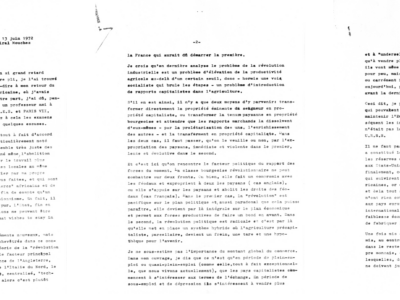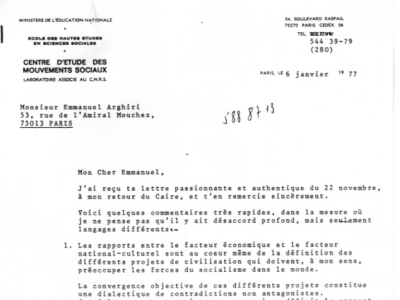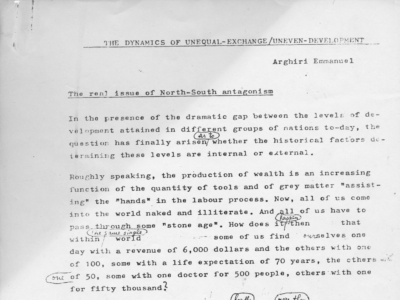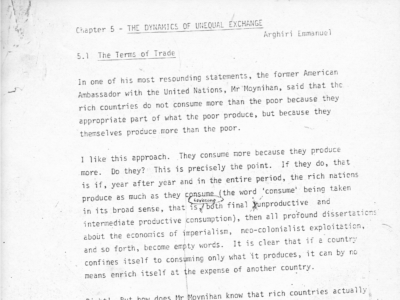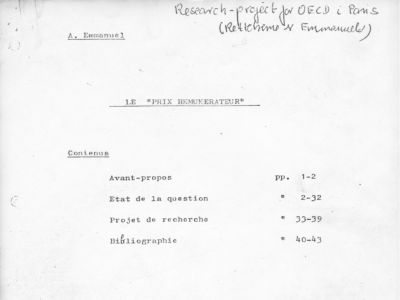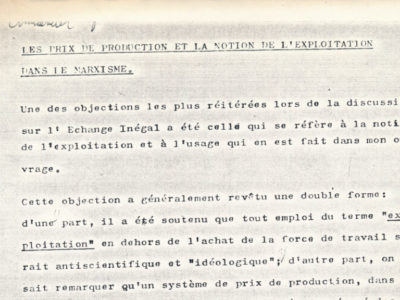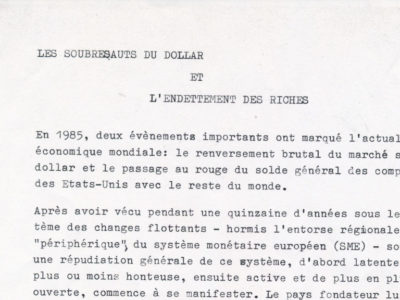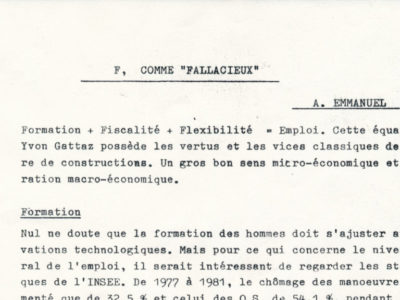Download the PDF.
(Conference on “New Approaches to Trade” at IDS, University of SussexJ 8.9.1975)
The Assumptions
Irrespective of any divergences between schools and theories, everybody will agree that ex post the price, , of a commodity “a” is strictly equal to the price of the material inputs :
, plus the price of the immaterial inputs, the so-called value added.
This second part is the total of the remunerations of the factors (or of their owners), that is of those who “contributed” (between inverted commas) to the production under question, or (without inverted commas) of those who are bestowed with an established claim on a part of the value of this same production. It is sub-divided into the part accruing to wages , and the part accruing to all other claims (profit, rent, interest etc.), and which, in a simplified model, we can aggregate under a single term,
.
In a system of k processes, we will then have:
Now, this system, as every system, must ultimately be linked to some determination from outside the system. The exogenous element ensuring this is the independent variable of the system. Eventually, it is the choice of this independent variable which splits up the economists into two major camps, the subjectivists and the objectivists.
For the former, this ultimate determinant is to be found in the area of circulation; it is the needs and preferences of the consumers. These needs and preferences determine the prices of final goods and the prices of final goods, in their turn, determine upwards the prices of the ’’productive services’’, according to the proportion each one of them “contributes” to the production of final goods. These prices of productive services correspond to the various shares in the national income.
On the contrary, value theories situated on the cost-of-production side consider that the system provides itself at each time and prior to prices with a certain pattern of distribution of the national income. This is the independent variable, varying exogenously and actually reflecting the power relation of the moment between antagonist classes or groups. Then the prices of the factors determine downwards prices of the different commodities produced.
In a simplified Ricardian or Marxian model, where the national income is divided into two shares only, wages and profit, the former being fixed before the sale of the product and independently of its results and the latter being residual, it is obvious that the ultimate determinant, the independent variable of the system, can only be the wage. What is more, under these conditions, the wage can only be conceived in absolute terms, actually as a physical quantity of the numéraire-commodity k, representing the output of one particular process of the system. (Regime of convertible currencies).
This is the primary basic assumption underlying all theorems of the Unequal Exchange.
When this assumption is transposed onto the international plane, it has to be further qualified. In the international framework, capital is mobile enough to generate a tendency of equalization of the rates of profit on a world scale, while labour power is immobile enough to prevent national discrepancies in the rates of wages from being levelled off by foreign competition. There is no such thing as an international wage, whereas any national discrimination of profits constitutes a more or less short-run anomaly.
Naturally, besides the above, the model contains usual general simplifying assumptions, namely absolute free-trade conditions, no government interferences, absence of customs and of transport expenses.
The Theorems
There are three main theorems in the Unequal Exchange argument. They bear respectively on the international division of labour, the international values and the problems of development.
The International Division of Labour
If specialization is made according to comparative costs, yet not in terms of physical costs, or social costs (whatever this may mean), but in terms of market prices, determined by and equal to the amount of the prices of factors,
if prices of factors are fixed in an extra-economic way, so that the cheapest factor is not necessarily the most abundant,
if quantities of factors are not proportionate to each other, at least from branch to branch in each country,
it may follow
that trade results in the wrong specialization with, as a consequence, general reduction of real income in the whole system.
Since the thing to demonstrate is a mere possibility, a numerical example would do.
Suppose that Ricardian costs, 80, 90, 120, 100 are composite, each one of them made up of two different factors, F and G, entering in the proportion of 5 to 3 into wines and 1 to 8 of into clothes.
| Totals | |||
| F | G | ||
| Portugese wine | 50 F & 30 G | ||
| Portugese cloth | 10 F & 80 G | 60 | 110 |
| English wine | 75 F & 45 G | ||
| English cloth | |||
If both factors have the same unit-price everywhere (e.g., one monetary unit), monetary costs will be the same (or stand in the same proportions) as Ricardian physical costs:
| Portugese wine: | |||
| Portugese cloth: | |||
| English wine: | |||
| English cloth: |
By either macro- or micrometrical standards, Portugal will specialize in wine and England in cloth. In that case,
| Portugal produces 2 “wine” with | 100 F & 60 G | |
| England produces 2 “cloth” with | ||
| and the whole system, for the same | ||
| aggregated production, spares | ||
Suppose now that the price of factor F doubles in Portugal, all other things remaining unchanged. Monetary costs will work out as follows:
| Portugese wine: | |||
| Portugese cloth: | |||
| English wine: | |||
| English cloth: |
As , England specializes in wine and Portugal in cloth. As a consequence,
| Portugal produces 2 “cloth” with | 20 F & 160 G |
| England produces 2 “wine” with | 150 F & 90 G |
| 170 F & 250 G |
and the whole system, for the same aggregate production, wastes (as compared with the pre-trade situation) 23 8/9 F and 6 1/9 G.
The above point has been disputed by David Evans on the ground that total quantities of factors employed after specialization do not square, country by country, with those employed before. For figures in excess, Evans argues that either the additional quantities of factors existed already and were formerly unemployed or they did not. If they did exist, maximization of their employment is welcome; if they did not exist, specialization could not have created them.
My answer is that (a) the goal is not the maximization of employment irrespective of the output, but the maximization of the output for a given employment, (b) as immobile as they may be from country to country, factors are not inelastic within the boundaries of one country as Heckcher-Ohlin have assumed. Specialization does create factors. Most of them are convertible into one another (produced out of one another). If they were not and if we abode by the usual oversimplified models where all products are exportable, not only my refutation of the comparative costs theorem but the theorem itself would collapse. For wrong specialization causes the imbalance pointed out by Evans not qua wrong but just qua specialization. In the first case above, specialization of Portugal in wine and of England in cloth, although quite right, would nevertheless make the former spend 100 F and 60 G instead of the previous 60 F and 110 G and England, 20 F and 180 G instead of the previous 86 1/9 F and 133 8/9 G. As soon as the plurality of factors and the variety df their proportions is introduced into the model, to find out figures satisfying Evans objection is as difficult with endogenous as with exogenous determination of factor prices. There is indeed no reason to suppose that the proportion of factors required for either branch is exactly the same to that of the existing quantities of factors in the country at the precise moment of the opening of trade.
To get over it, one has to make some supplementary assumptions: existence of unexportable and interchangeable commodities, of second-best techniques (especially in these home orientated branches) and, above all, the fact that all factors, even “primary” ones, except perhaps the roughest uncultivated land and the rudest illiterate labourer, are themselves, in the long run, being produced out of one another. (Germany does not specialize in chemicals because she got an abundance of chemists but she produces chemists abundantly because she is specialized in chemicals).
On the other hand, if the exogenous (institutional) forces determining income distribution are strong enough, factors which are immobile in the economic sense, may very well be as mobile physically as is necessary to palliate technical distortions of the sort pointed out by Evans. Reciprocally, when the market for a factor is free enough, a small physical mobility may in some circumstances be sufficient to implement what we call ’’mobility” in the economic sense. The massive immigration of South-European and North-African labourers of recent years had no effect at all on the wage rate gap between home and recipient countries, whereas marginal capital movements, absolutely insufficient in physical terms to promote quick development of the Third World, proved nonetheless quite sufficient to bring about a tendency of equalization of the rate of profit.
Now, if we reason in terms of maximization of the output instead of minimization of the inputs, we can use the following numerical example bringing into play the two traditional factors, labour and capital, and two goods, j and k, making up all inputs and outputs of the system.
Let us write ,
for price of j, k
,
,
,
for rate of profit in country A, B resp. in autarchy and rade situation.
.
All wage rates are equal to 1k.
The proportions of factors (techniques) are the same from country to country but not from branch to branch. In branch j, this proportion is a fixed capital of 80j and 8Ok for 10 units of labour, while in branch k, it is 10j qnd 10k for 10 units of labour. Country A produces 10j and 100 k; country B produces resp. 12 and 80. If monetary wages are the same everywhere in terms of an international standard, viz., one k for one unit of labour, and if constant circulating capital (intermediate consumption) is abstracted, we will have the following equations:
| Totals | |||||||
| Country | Br. | Wages | Profit | Output | Solutions | J | K |
| A | J | 10 | |||||
| K | 100 | 100 | |||||
| B | J | 12 | |||||
| K | 80 | 80 | |||||
| Total autarchy production | 22 | 180 | |||||
| A specializes in K and produces | 200 | ||||||
| B specializes in K and produces | 24 | ||||||
| Aggregate inputs being the same, overall gain is | 2 | 20 | |||||
Suppose now that wages in A are multiplied by 6, all other things remaining constant Equations in A will turn out:
| A | J | ||
| K |
As , A specializes in j and B in k.
Obviously, this is the wrong specialization, since with the same aggregate inputs our system will produce 20j and 160k, instead of 22j and 180k in the autarchy situation or 24j and 200k in the inverse specialization.1
To be sure, if we have been able to say which one is the wrong specialization and somehow to measure the loss, this is only due to the oversimplification of our examples and to prearranged figures allowing both inputs in the first example and both outputs in the second to vary in the same direction, thuş making it possible to compare heterogeneous physical magnitudes independently of the prices. But when inputs and outputs become more numerous, such combinations are practically impossible. But the very fact that certain variations in the distribution of income, that is mere transfers of value from one economic agent to the other, without any change in the material conditions of the production, entail a reswitching of specializations is sufficient in itself to prove that free trade does not necessarily lead to the optimal division of labour, even it it does not enable us to say which one is sub-optimal and by how much.
Let us now revert to the specialization with equal initial wages. After-trade equations will run as follows:
| A | K | |
| B | J |
If (Ricardian condition), we shall have in the system one more degree of liberty and we must take as given exogeneously one of the three unknowns,
,
,
. Rates of profit being residual, the only variable which, under the circummstances, can be exogenous is
and here we are with the neoclassical story of demand elasticities fixing freely the ratio
between the limits of comparative costs. In the above example, these limits are 73, 47,5.
At workers in country A gain to the extent that they buy j and workers in country B neither gain nor lose anything. At
, workers in country A neither gain nor lose, while workers in country B lose to the extent that they buy j. At a medium price,
, gains and losses are equal for every unit of j bought by the workers of either country. Below the medium price, workers of A gain more than what workers of B lose and above that price the effect is contrary. Workers gain or lose to the extent that they consume the imported or the exported article, being given that with the opening of the trade the former becomes cheaper and the latter dearer.
As regards rates of profit, at , there is of course, no variation in country B, but the rate of profit in country A rises from
to
; at
, the rate of profit in country A remains unchanged, but that of country B rises from
to
. In all intermediate prices, both rates rise. This means that even in cases where the aggregate working classes of both countries is better off –
– both capitalist classes get a higher rate of profit too.
If we pass now to the second case of specialization, with unequal initial wages, we have the following after-trade equations;
| A | J | |
| B | K |
Abiding by the same assumption, we see that according to the elasticities of international demand
will vary from 38k to
and that workers throughout the system will be better or worse off to the extent that they consume the imported or the exported article exactly as in the previous case of “right” specialization.
But those are gains or losses in use values. In terms of abstract value, that is, in terms of the homogenizing element (units of k), wage rates have been assumed to be rigid. Consequently, if specialization – either right or wrong – does not cause a variation in the level of the employment – as in the above example – the mass of the wages, in monetary terms, will also remain unchanged. It is then the mass of profits which will be reduced to keep in line with the reduction of value added subsequent to the wrong specialization.
But the decline of the mass of profits may very well be consistent with a rise of their rates, if the wrong specialization involves either the dropping of some capital out of business, or – as in the above example – the transfer of a certain amount of capital into the pre-trade low rate country. Contrary to a previous assertion of mine – last March in Sussex – I think now that neither rate of profit can decline as a result of a wrong specialization.
To put it concretely: some factor being under or overvalued in England or in Portugal, English wine and Portugese cloth acquire a monetary comparative advantage, notwithstanding their physical disadvantage and begin to arrive resp. at Portugese and English ports underselling local productions. Portugese vineyards and English textile mills will be destroyed and this will be a pity for the aggregate performance of both countries. But, cloth rising in Portugal in terms of wine and wine rising in England in terms of cloth while neither cost of production has risen, there is no reason for pre-trade rates of profit in the surviving branches resp. Portugese cloth and English wine, to fall.
In this respect, I must refer to a misunderstanding created by some poor passages of the second chapter of my book and of my tables in pages 62 and 63. The decline of the rate of profit of country B which is only implicit in these tables is linked with the passage from non-mobility to mobility of capital and not with the one from pre-trade to after-trade.
The unequal rates which can be deduced from my model as previous rates of profit, for resp. country A and country B, are not the rates of profit in the autarchic situation but rates of profit after trade and specialization, though before financial circulation and equalization of profits.
In the passage from pre-trade to after-trade situation, rates of profit rise generally: in the passage from non-equalization to equalization, general rate of profit will necessarily lie between, the previous national ones.
The International Values
We pass now to the second stage. It is characterized by free financial circulation added to the free commodity circulation already attained at the previous stage and entailing a tendency towards the formation of a general rate of profit.
As soon as we assume that , the degree of liberty (indetermination zone), which we found above on the basis of the contrary assumption (
), vanishes,
becomes an unknown endogenously determined (along with the common rate of profit), and there is a single solution, which in the above numerical example is
5/6 k,
.
In other words, as long as the capital was immobile, the terms of trade were freely floating – according to the whims of reciprocal demands – within the limits of the Ricardian limbo. The only relevant question then was how the entire limbo moved about when the distribution of income was changing (in the above example from the range (73 – 47,5) to that of (47,5 – 38). But when mobility of capital starts up, the terms of trade become predetermined by the absolute differentials of monetary costs, consequently by the discriminating (immobile) element in those costs and there are no more limbos.2
In the real world, the most important discriminating factor is the wage and this is why the main theorem of the Unequal Exchange is formulated in terms of wage variations. Theoretically, however, it could equally be formulated in terms of any factor varying exogeneously along national lines, for instance, rent.
Since all demonstrations I am capable of have already been presented in my previous (long) paper, I shall here confine myself to give a mere enunciation of the theorem:
In a system of two or k countries (already trading and specialized in two or k articles),
if all w’s (wages) are given exogeneously, prior to anything, in terms of units of one among the k goods,
if the rate of factor r is equalized throughout the system but fixed simultaneously and in mutual interdependence with prices of goods, a unique set of prices being consistent with this equalization,
then,
any autonomous variation of some will entail q variation of the same sign of respective
(price of i) and a reverse variation of (general) r, viz.,
and
,
and, as a consequence,
it will entail a variation of the real revenue of people receiving all other w’s, variation of the opposite sign to that of the variation of and proportionate to their relative consumption of i, notwithstanding the monetary constancy of these other w’s.
From this presentation it is already clear that the inequality of exchange is not meant as a difference between ‘’value” (in labour terms) and price, but between price and price. In order to dissipate any misunderstanding which could stem from possible ambiguities in my early definitions, I gave in the second French edition of my book the example of Katanga copper being exchanged against Belgian shoes:
| Engaged | |||||||
| K | c | v | s | Value | |||
| profit | |||||||
| production | |||||||
| shoes | 200 | 120 | 80 | 80 | 280 | 15% | 230 |
| copper | 800 | 100 | 10 | 70 | 180 | 230 |
The higher organic composition of copper mines more than compensates for higher Belgian wages and, as a result, more Belgian labour (living and dead altogether) pays for less Katangese labour (280:180). Yet, in my view, it is Belgium that exploits Katanga through unequal exchange, not the other way round.
In relation to what is this exchange unequal? In relation to the situation where wages would be equalized. It is as simple as that.
After such an equalization the scheme will read:
| K | c | v | s | V | r | Price | |
| Shoes | 200 | 120 | 80 | 80 | 280 | 12% | 224 |
| Copper | 800 | 100 | 40 | 40 | 180 | 236 |
Inequality is expressed by .
It is also quite clear that what matters is not the barter terms of trade but the factoral ones. No scheme in my book indicates any quantity of use values and any unit price, and without the latter no reference whatsoever to the barter terms of trade can ever be made.
In the above example, we do not know what the barter terms of trade are, but it is directly visible that the factoral terms of trade are detrimental to Katanga since both countries exchanged only two onerous factors, capital and labour, the former equally remunerated, the second, 4 times more in Belgium than in Katanga.
Two major objections have been formulated against this theorem. They refer to the need of consistency of the terms of trade, resp. with the balance of payments on the one hand, with productivity differentials on the other. Both mistake to some extent the permissive condition for the cause of the phenomenon, but both correspond to respective deficiencies of my early writings.
Price-elasticities of the demand
The first objection claims that Unequal Exchange is a self-defeating process. Who will buy the ever rising high wage burdened developed countries export commodity? Poor foreign customers – getting even poorer by the very inequality of the exchange – can find nowhere the additional means of payment corresponding to the increment of price of that commodity. Consequently, either the quantity exported and produced will be reduced or a devaluation of the national currency will offset the effect of the increase of its nominal price. Both solutions will cancel the rise of wages; the former indirectly through unemployment, the latter directly.
What the objection overlooks is a third possibility: reduce the export of the advanced commodity without reducing its production. The answer to the query is that it is the workers of the supply country itself who will buy the quantities corresponding to the rise of the price. One can gain to another’s detriment not only by giving the same for more but also by giving less for the same.
Here is an example showing the way the trade can be balanced:
| Country | Branch | Wages | profit | output | Solutions |
|---|---|---|---|---|---|
| A | J | ||||
| B | K |
Since there is neither intermediate consumption nor depreciation, total output, 100J + 400K, is the net product of the system. Assuming simple reproduction and identical indifference curves for all classes in both countries, consumption proportion will be 1J : 4K, and balance of payments will run:
| In A | capitalists consume | 32J | ||
| workers consume | 28J | |||
| Country A consumes | 60J, | produces 100J; | exports 40J |
| In A | capitalists consume | 128K | ||
| workers consume | 112K | |||
| Country A consumes | 240K, | produces |
exports 240K |
| In B | capitalists consume | 32J | ||
| workers consume | 8J | |||
| Country B consumes | 40J, | produces |
exports 40J |
| In B | capitalists consume | 128K | ||
| workers consume | 32K | |||
| Country B consumes | 160K, | produces |
exports 240K |
| In value terms | Income | ||
| In A | capitalists consume | ||
| workers cosume | |||
| A’s income: |
|||
| In B | capitalists consume | ||
| workers consume | |||
| 400 | |||
| Totals | 1000 | ||
After the rise of wages in A.
| A | J | ||
| B | K |
In real terms, income of workers in A is improved, that of everybody else worsened. Assuming that J is the luxury article, the indifference curve of A workers must shift to the favour of J, those of all other classes in both countries in the opposite direction, in such a way as to keep the average, 1J:4K, constant. If we suppose that these proportions are now 1J:3K for A workers, and 1J : 5 3/31K for all others, the trade balance will run:
| In A | capitalists consume | |||
| workers consume | ||||
| Country A consumes | produces 100J; | exports |
| In A | capitalists consume | |||
| workers consume | ||||
| Country A consumes | produces |
exports |
| In B | capitalists consume | |||
| workers consume | ||||
| Country B consumes | produces |
exports |
| In B | capitalists consume | |||
| workers consume | ||||
| Country B consumes | produces |
exports |
| Income | |||
| In A | capitalists consume | ||
| workers cosume | |||
| A’s income: |
|||
| In B | capitalists consume | ||
| workers consume | |||
| 400 | |||
| Totals | 1400 | ||
Following the increase of from 6 to 10, all demand elasticities have worked plausibly. The demand of the enriched workers in A rose sharply for the luxury article J, but less for K. The demand of the impoverished capitalists of both countries and of workers of B fell considerably for J, but only slightly for K. Yet there has been neither deficit of the trade balance nor reduction of the production of J. Certainly, figures have been carefully chosen to bring the case home. But this is immaterial. There exists an infinite number of equally well fitting combinations. What has been decisive, is the assumption of an aggregate price-elasticity of the international demand for J being less than unity; namely 0,906.
Generalizing for 2 articles, J and K, and writing and
, for the demand of J and K, we can say that
when is multiplied by x,
,
is multiplied by y,
, and
is multiplied by z,
.
For the trade balance to be equalized or in surplus it is necessary that
R symbolizing the rate of exchange and ,
rasp. the exported quantities of J and K.
To isolate the effect of x we must assume that trade was balanced before x:
Now, by definition
,
,
representing respective increments either positive or negative.
Therefore by substitution in [eq:condition2] have the final form of the no deficit condition:
Is that condition usually fulfilled in the real world? That is the relevant question. Everything happens indeed as if it were. A price-elasticity of the demand generally (or even usually) greater than unity seems to be a myth. It constitutes of course an indispensable postulate of neo-classical constructions but it has never been substantiated by any reliable statistical evidence.
An economist as traditionalist as Jacob Viner is compelled to acknowledge: “It is true that all or nearly all statistical investigations of the price-elasticities of demand… have found… substantially less than unity”3. To be sure, he adds that relative statistical data are questionable. If, however, these are the only available data, one cannot see how the mere fact of their uncertainty could warrant the contrary belief in an elasticity greater than unity.4
The above model expresses but a mere possibility. So does, in the opposite direction, the argument it answers. To fight it out we must refer to the facts. Now, the only facts we got are, on the one hand, a “bad” piece of statistics showing a low price-elasticity and, on tho other hand, a good historical evidence showing a deepening of the wage gap and a continuous rise of industrial countries export prices, accompanied, not by a deficit in their balance with the underdeveloped countries, but by a small surplus.
What happened? Who consumed this ever growing flow of “dear” commodities? The answer is given by the same statistics: the volume of foreign trade within the zone of developed countries has progressed, since 1950, 1,7 times faster than the trade between the zones. The bulk of high wage commodities has been exchanged and consumed between and by high income peoples themselves, more or less in the fashion roughly outlined in the simplified J-K example above.
Wage differentials must be consistent with the equilibrium of the balance of payments, argue the critics. They are. The fact that they exist side by side prove that they are.
Productivity
Wage differentials must also be consistent with productivity differentials, add the critics. Otherwise, capital will move in a one-way flow towards low-wage countries and either it will level off the wage gap by raising the bids, or – if this is barred by institutional obstacles – it will have rents created under cover of these obstacles. In both cases the “inequality” of the terms of trade (either barter or factoral) will cease.
This argument has been formulated again and again, worded in various ways and lately strongly upheld by Robin Murray in our previous discussions here in Sussex. It has two bearings, one on the problem of the international value and specialization, and the other, on the uneveness of development. I shall start here with the first point.
I am now aware that the way I tried to get rid of this objection has so far been unsatisfactory. The argument certainly deserved more attention than I thought it advisable to pay.
I used to bring into focus the various viscosities and shortcomings in the international movements of capital, specificities and contradictions of inducements to investments etc., all things lying outside the model. This was not permissible in this particular case because it so happened that the very abstraction of these same impurities was essential to the model in order to lay down my prime hypothesis of a tendency towards an equalization of the rate of profit. This abstraction ought therefore to be adhered to for better or worse.
Of course, as I said above, marginal movements of capital may be sufficient for the equalization process but not so for the development process or for other purposes. However, they must at least be sufficient to generate equalization on the margin. That means that, at the moment the rate of profit in the invested branches becomes equal to the international one, the expected rates of profit in the eliminated branches must range from equal to to smaller than it. Otherwise, the former second-best branch becomes bettor than the former best. Then, even if a new flow of capital is, for any “practical” reasons at all ruled out, the already existing capital inside the low wage country (assumed sufficient for bringing the rate of profit of the primary sector down into line with the international level, despite sectoral high productivity and national low wages), will itself flow from the traditional export article to the import substitute. As a result, the trade of the high wage country will move into the red and there will remain but two ways to restore equilibrium: either a devaluation of its currency, or an increase of the rate of profit in the traditional sector of the low wage country beyond what the import substitute can pay. The former means cancellation of wage differentials; the latter, restoration of profit differentials. Both thwart unequal exchange.
I must therefore admit that unequal exchange is impossible without productivity differentials making good wage differentials in all branches eliminated by trade in the low wage countries.
To the extent I am able to have a clear look into my own deficiencies, I think my mistake stemmed from a certain discontinuity in my passing from the specialization problem to the terms of trade. Despite my own demonstration that the solution of the specialization problem depended on the standard used, I came to consider location, once established, as irreversible by any standard. I then treated cloth in Portugal and wine in England as merely impossible productions.
Surely, Portugese cloth, despite its superior productivity (90:100), was supplanted by English cloth but it was so only thanks to the flexibility of factor prices in the Ricardian model.
As I, myself, had shown, Ricardian physical costs,
| Wine | Cloth | |
| Portugal | 80 | 90 |
| England | 120 | 100 |
could allow trade only if escudo-shilling change was modified so as to have monetary costs inserted within the following two sets of borderline proportions:
| Wine | Cloth | Wine | Cloth | |
| Portugal | 100 | 120 | 135 | |
| England | 120 | 100 | 120 | 100 |
This means that Portugese factoral income had to be superior to the English one by at least and could be by as much as
, these being Portugese positive productivity differentials in the one and the other branches. With Ricardo, this did not give rise to any problem, since prices were the active and factoral incomes the passive element. My mistake consisted in forgetting these borderline constraints when I overturned the causality and took factoral incomes as the active autonomous element.
Does this borderline link with productivity constitute something of a blow for the core of the theory of unequal exchange? I do not think so. And this is perhaps my only excuse for my former superficial treatment of the matter, viz., the consideration that in any case this did not make any essential difference.
Why did my critics value this point so much? For two main reasons. Some of them, especially Marxists, thought that this was a good demonstration of the priority of production over circulation. Others looked, consciously or unconsciously, for some ethical argument against the thesis of international exploitation. Both confused the limits of wage movement with its driving element.
Productivity differential are indeed setting limits (just limits) to wage differentials. But the existence of an endogenous limit to a variation does not transform an exogenous variable into an endogenous one. The nature and the role of these limits are exactly the same, whatever the exogenous variable acting within the indetermination zone circumscribed by them. As far as those nature and role are concerned nothing is changed by substituting the Unequal Exchange independent variable for the neo-classical one – income distribution for demand elasticities. If production relations are not determinative within the second framework – and I do not think that Robin Murray would describe neo-classical theory as particularly pinnacling production relations –, they are no more determinative within the first.
What is much more important, wage “independence” on productivity does not concern only the magnitude of the variations; it concerns their sign as well.
Indeed, the universal superiority of one country over the other, expressed by the Ricardian example, is not at all a faithful picture of the real world. Real Portugal and real England are more productive in one sector and less in the other. Nothing in the technical texture of production can give us the slightest a priori indication, not only of how much the wages will be higher here than there, but even of which one is likely to become the high wage country and which one the low wage country.
Moreover, to the extent that some quantification of the technical comparative advantages is at all possible, their dynamics appears clearly to be the opposite of actual wage movement trends. For it so happens that the technical superiority of the low wage countries in the exported primary commodity is considerably greater that their inferiority in the imported industrial one.
Let us go back to our example:
A. With equal wage rates:
A1. Autarchy
| Count. | Br. | Wages | Profit | Outputs | Solutions |
|---|---|---|---|---|---|
| A | J | ||||
| K | |||||
| B | J | ||||
| K | |||||
| Obviously A specializes in J and B in K | |||||
| A2. Trade without profit equalization: | |||||
| A | J | ||||
| B | K | ||||
| A3. Trade plus equalization of profits: | |||||
| A | J | ||||
| B | K | ||||
If A is the industrial and B the agricultural country, the above figures of technical performances are fairly (rather on the moderate side) realistic. A has a good advantage (+ 2/3) in the industrial commodity J; B has a greater advantage (+1 6/7) in the primary commodity K. On the basis of these data either we can say nothing about future evolution of wages in either country, and this is a sufficient proof of wage independence, or we will be bound to say that it is B wages which are more likely to rise, and the falsity of this say is a still better proof of the independence under question.
The only thing that is certain at that stage, is that there are limits in the increase of wages in either country and that those limits stem from the constraint that J must be available in country B at a price equal or inferior to 10K, () and that K must be available in country A at a price equal or inferior to
,
. Otherwise, B resumes local production of J or A resumes local production of K.
These price-limits determine wage increase limits, resp. 2 3/7 times for the industrial country A and 4 1/4 times for the agricultural country B. The greater potentiality of wage increase of the agricultural country reflects its overall superiority in productivity. (This same superiority was reflected in its superior before-trade rate of profit, i.e., 0,145 as against 0,068 in country A.)
B. After-trade increases of wages:
| 1) Maximum possible in A | |||||
| Count. | Br. | Wages | Profit | Outputs | Solutions |
| A | J | ||||
| B | K | ||||
| 2) Maximum possible in B | |||||
| A | J | ||||
| B | K | ||||
If it so happens that wages in A rise and hit the above ceiling, (2 3/7 times), Robin Murray will say that, this is only possible because of the superior productivity of A in J (production of 50J as against 30J in B for the same inputs). Yes indeed! But this is a necessary not a sufficient condition. The relative performance of B in K is far more brilliant (200K as against 70K in A for the same inputs). Yet it is not B but A wages that went up and kept going up for the last century. Such a long-run, systematic, “perverse” behaviour of the wages with respect to comparative productivities could not bo explained but for an exogeneous factor independent of productivities.
Now, as regards those who are interested in ethical considerations, I should say that even prior to the above argument on productivities, even assuming that overall productivity in high wage countries were overwhelmingly superior to that of the others, even within the framework of the bourgeois law – “to each one according to his capacity” –5 one could not see why the same quantity of labour of the same qualification, incorporating the same learning and training should be paid ten times more or less according to whether it is supplied some miles on this or the other side of the Amorican-Maxican border and according to whether the name of the vendor is John or Fernandez. Of all monopolies, this one, grounded on a passport or a birth certificate, seems to me the most “un-ethical”.
Whatever the productivity differentials, obviously those cannot be the outcome of the labour itself. Neither the labour power nor any other power in the world can yield more than it contains itself. At equal labour, an unequal yield can only be generated by some other factor, generally land or tools. But land and tools have already charged the product with resp. rent and profit. To charge it further with a wage differential amounts to making the consumer pay twice the same “productive” service, if we admit that land and tools represent indeed a productive service, or to making him pay twice for nothing, if we don’t.
To differentiate either rural wages according to the quality of the plot the labourer happened to till, or industrial wages according to the quantity and quality of the machines the worker is harnessed to, is the most absurd thing one could ever imagine.
By capitalist standards, the fruit of land and tools belong resp. to landowners and capitalists; by socialist standards, they belong to the world working class at large; by no standards, they would belong exclusively to the individual workers who happened to use them or to those who happened to live within the frontiers of the country in which they are located.
Now, if the inequality of productivity can hardly, in itself, provide an ethical excuse for an inequality of wages, the fact that anyway, when all advantages and disadvantages are reckoned up, it is not high wage but low wage countries that can vindicate an overall average superiority on the side of productivity, makes the inequality of wages in the opposite direction all the more unjustifiable.
Development
As regards development, the objection outlined above can be put in the following way.
- In pure economic terms development is nothing else but the rise of the productivity of labour.
- Comparing the productivities of labour in heterogeneous processes is only conceivable in terms of the organic composition of capital, (occ).
- The growth of occ can be fostered only by new capital, either home made or flowing in from abroad.
- If the international mobility of capital is as good as to bring everywhere the rate of profit down to the international level, it should ipso facto be also as good as to implement everywhere the highest occ, corresponding to the most advanced technology of the moment. Underdevelopment becomes therefore materially impossible, unless it is itself the autonomous variable, determining the wages instead of being determined by them.6
Abstracting ’”organic composition of labour” (proportion of qualified labour to total manpower) for the sake of simplification, (a), (b) and (c) are right. Labour being the only biologically limited factor, productivity of labour is indeed the only relevant magnitude for reckoning up the potential of material welfare of any human society and therefore the only meaningful element in the concept of development.
It is also true that the higher the occ the greater the output per unit of labour employed. (Otherwise, the more capital intensive technique is not valid by any standard). It is further undeniable that now capital is formed out of saved profits and not out of saved wages and that therefore the increase of wages, however it may improve one’s terms of trade, raise one’s standard of living, increase one’s national income, can by no means implement one’s extended reproduction and therefore development.
But it does not follow from these premises that any capital intensive technique, valid by social standards, is also valid by capitalist standards. In other words, it does not follow that capitalists are liable to choose in all circumstances the technique which generates the greatest productivity of labour. Capitalists are interested in the yield of their capital, not in the productivity of the labour they hire. It so happens that techniques that maximize the latter do not necessarily maximize the former. It precisely depends on the level of wages.
For the sake of simplification, we chose, in our example, an occ different between branches but identical between countries. If we now drop this unrealistic assumption, we can suppose that there are two available techniques for K one more productive than the other:7
At the more productive technique,
is also the more profitable.
| Country | Branch | Wages | Profits | Outputs | Solutions |
|---|---|---|---|---|---|
| A | J | ||||
| B | |||||
| A | J | ||||
| B |
The “heavier” technique, , is here more profitable:
.
On the contrary, at , the less productive technique is the more profitable and it is this one that is chosen by capitalists.
| Country | Branch | Wages | Profits | Outputs | Solutions |
|---|---|---|---|---|---|
| A | J | ||||
| B | |||||
| A | J | ||||
| B |
Since the “lighter” technique
becomes more profitable. Development in B is now blocked. This time, capital flowing into B is sufficient for equalizing the rate of profit but not sufficient for pushing development ahead. A similar bias in the choice of techniques stems from differentials in the scales of remuneration of qualified labour (“organic composition of labour”). Cheap muscles phase away brains and machines in the low wage countries, while brains and machines displace costly muscles in developed countries.
28.7.1975
Appendix
After I had written the main text, I received a Samuelson’s paper (probably published meanwhile), concluding that with given positive profit rates some inefficient situations for the whole system (general welfare reduction) can emerge if the rates are unequal, but no intertemporal inefficiency is involved if profit rates are equalized throughout the world. “Thus”, ends Samuelson, ’”the Emmanuel doctrine of unequal exchange… turns out to be the reverse of the truth to the degree that it believes profit equalization leads to inefficiency” .
Notwithstanding the fact that, in any casa, Samuelson’s argument is based on the assumption of equal wage rates, r being the independent variable, and consequently can by no means be related to my own analysis (this being furthermore based on unequal monetary wages and not “unequal real wages”, as Samuelson thinks it is based), the above particular statement of his induces nevertheless me to qualify my position.
I have to no degree ever believed that “inefficiency” (sub-optimal specialization) depends on equalization of profit rates, still less that it is worsened by it. I dealt with “inefficiency” prior, therefore independently, of equalization. What equalization, in itself, involves, is not an additional “inefficiency” of the whole system, but a re-sharing of the cake in favour of the partner possessing the best remunerated other (immobile, therefore “non-equalizable’’) factor.
In other words, one could perhaps say that I believe in profit equalization leading to spoliation, if one likes to put it that way, but certainly nothing in my writings can make one say, as Samuelson says, that I believe in equalization leading to inefficiency.
Nevertheless, it is also true that I have never said the contrary either, and to the extent that Samuelson’s paper draws my attention to the profit-equalization’s probable effect of moderating the perversity of the ’’unequal” factor (as far as inefficiency – not spoliation – is concerned), it contains a new and interesting statement.
In order to round off the analysis and rule out any similar misunderstanding, I think it advisable to work out in an orderly line all possible combinations between ”reswitching” and “non-reswitching” exogeneous variations of factor prices and endogenous equal-unequal, rates of profit, within the framework of a single example reproducing the Ricardian final comparative cost ratios.
I
With one only exogeneously priced (primary) factor.
AUTARCHY
| Country | Branch | ||||
| factory | Profits | Output | Solutions | ||
| Portugal | Wine | ||||
| Cloth | |||||
| England | Wine | ||||
| Cloth | |||||
| p: price of wine in terms of cloth, | |||||
Since , Portugal specializes rightly in wine and England in cloth. We are straightway able to say “rightly” because it so happens that in this particular example the greater physical superiority (more output for the same inputs) of Portugal in wine as compared with its physical superiority in cloth (
) is as visible as the financial one. But this is not necessarily always the case. Yet the simple fact that certain autonomous variations of factor prices lead to a reversal of the financial “comparative advantages”, and hence, under competition, are liable to induce the decision makers (independent private producers) to revert the geographical location independently of the physical data, is a sufficient proof of the breakdown of the Smithian “invisible hand”.
Samuelson’s paper misses the point. He strives to demonstrate that in his US-UK, food-clothing example, despite the visible private-cost-side superiority of US in clothing (at ), it is the opposite specialization which maximizes the aggregate, long-run, “intertemporal” consumption and which should therefore be chosen by society. He forgets that our issue is not whether or not society must chose US specializing in food and UK in clothing, but whether wise, independent capitalists will indeed, under the circumstances, invest in and produce food in US and cloth in UK or the other way round.
Trade without equalization of r
| Country | Branch | ||||
| factory | Profits | Output | limbo | ||
| Portugal | Wine | ||||
| Englanc | Cloth | ||||
- This example will perhaps prove more acceptable on the basis of Evans objection to the extent that the quantities employed of the physically given and immobile factor do not vary with specialization, whereas the varying factor may be considered not only as being itself produced at will out of the other factor but also as physically mobile from country to country (even before equalization of rates of profit).↩︎
- And no more specialization (location) problem either. We have successively visualized the situation with neither trade nor mobility of capital, the situation with trade but no mobility of capital and the situation with both. We did not speak of a situation with mobility of capital but without trade. Such a situation would be mere nonsense, since the only vehicle of a flow of capital between countries is goods (and services). Transfer of capital is just another term for the creation of an international asset out of an unbalanced trade. Trade is a necessary, though not sufficient, condition of capital movements.It follows that at the moment we assumed equalization of the rates of profit – as we did in the tables of pages 62,63 – all location problems were things of the past.
This distinction was somewhat blurred in my book and that is what generated the misunderstandings referred to above.↩︎
- J.Viner, International Trade and Economic Development, Lectures delivered at the National University of Brazil, Oxford, 1953, p.27.↩︎
- Time and again, orthodox economists are being shocked by discoveries of some dramatically low elasticities. Oil price has recently been multiplied by 4, and the world demand in volume was hardly reduced by 20%, not to mention the fact that a great part of this reduction was not due to the increase of price but to a severe recession which broke out meanwhile in the consuming countries. At the same time, a nearly general boom of raw materials showed also extremely low price-elasticities of their demand.↩︎
- “bourgeois”, according to Marx.↩︎
- By the way, this is the approximate meaning I had been able to gather from a written exposition of the argument that Robin Murray let me have last March.↩︎
- J’s technque and wages remaining as in p.24 above↩︎


